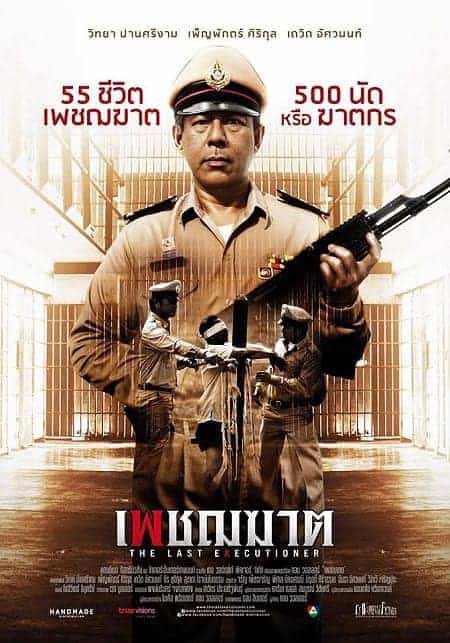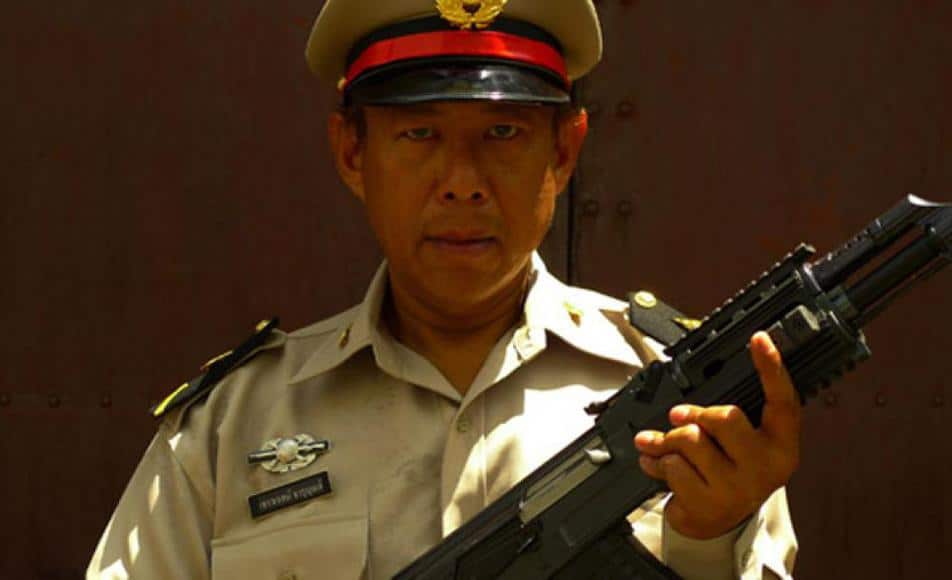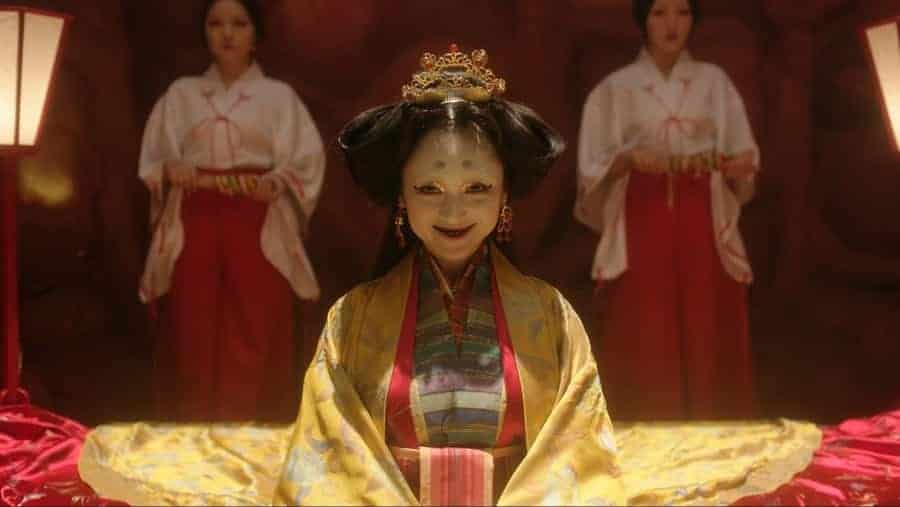After his feature “Mindfulness and Murder” (2011), Thai director Tom Waller found his next project in the form of an obituary in a local newspaper. The announcement was about the death of Chavoret Jaruboon, something of a celebrity in Waller's home country, since he was the last executioner carrying out death sentences via firing squad. When Thailand's government abolished death by firing squad in 2003, Jaruboon also resigned. Since his formal appointment to the position in 1984, he had been responsible for 55 executions, all of which were carried out with him shooting the prisoner with a mounted machine gun. In the years until his death, he was a regular guest on TV shows and wrote books about his time as executioner.
Buy This Title

Interestingly, the study of former executioners such as Jaruboon provides many noteworthy aspects for the discussion about the necessity of capital punishment in general. In an article about Albert Pierrepoint, the last British executioner carrying out death by hanging, author Lizzie Seal introduces the concept of the “haunted hangman”. While choosing their duty towards their country and their families as narratives for their profession, some of them describe also the trauma of guilt and regret resulting from their job. Writer Susan A. Bandes begins her essay on the debate about the death penalty in general, with the question whether one can truly ask anyone to perform a task such as the one Pierrepoint and Jarubon had to perform. As a consequence, one needs to discuss how any judicial system can spend a large amount of resources on maintaining capital punishment.
In the end, both Pierrepoint and Jaruboon explained how they became either opponents of or at least skeptical about the practice whose resources could have been used better in the field of crime prevention. However, the most fascinating aspect of the life of the latter for Waller was the strange contradiction of a man who would pose willingly with a machine gun while performing as an Elvis imitator in other pictures. Besides these points, the character was interesting for a country still defined by religion and superstition, most importantly the concept of “karma”. For a true Buddhist such as Jaruboon, doing his duties as executioner naturally would lead to an immense conflict with his own principles, which is what he also describes in his various books. Despite the morbid theme and the existence of two films on the topic, Waller eventually found the necessary financial support for his approach towards a very controversial figure.

Thailand in the late 1960s. Because the country has become a place for American GIs to relax and party away from the war in Vietnam, the influx of American culture, especially rock'n roll-music can be felt anywhere. Chavoret (Thira Chutikul) plays the guitar in a band, making just enough money to get by. When he meets Tew (Suchada Rojmanothum) and the relationship develops into something serious, the days of rock'n roll are over and the young man has to find a steady job. As their first child is on the way, a friend of his tells him about Bang Kwang Central Prison searching for prison guards. After his training, Chavoret becomes a guard and is eventually assigned to accompanying death row prisoners to their execution.
In 1984, Chavoret (Vithaya Pansringarm) is given the opportunity to make more money as the new executioner. Even though his family needs the money, he is hesitant after having witnessed so many executions himself during his time in prison. As he searches for answers in his faith with the support of the local abbot (Jaran ‘See Tao' Petcharoen), and with the heavy burden of his family's debt, Chavoret finally becomes the next, and eventually final, executioner of Thailand.

Although Chavoret certainly was an interesting persona, even Tom Waller himself had to admit, his private life was not that exciting. Being a civil servant, it consisted mostly of routine and his duty towards his job as well as his family. However, the script written by Don Linder provides not only an interesting narrative approach to the character, but also offers two concepts of approaching what is essentially an uncomfortable topic, to say the least.
For example, in one of the most revealing scenes for the nature of Chavoret, he shows his relationship to death and his family. Staged as a family meeting, Vithaya Pansringarm's character tells his wife and children about the money on his bank account, how his savings and his insurance will secure their lives for years to come. Since the news does not bring any smiles or other signs of joy to the faces around him, he eventually leaves the table saying he hopes the mood will have changed upon his return. Just as writer Kong Rithdee points out in his review of the film, in a film whose central character defines himself through disguising or hiding his emotions, Waller repeatedly shows how this estranges Chavoret from his family. Paradoxically, the nature of his job – meant to secure his family's future – has only widened the emotional gap between them.
In order for this approach to work, Vithaya Pansringarm's performance is the key ingredient. His exchanges with the abbot, his wife and his colleagues at work establish an approximation of what drives this character. The constant invocation of “duty” as a core theme in his life – the obligation to his family, to his father, to his work, to his country, to his faith – point at the question of what is left of the corny Elvis impersonator from the beginning. Within the development of the action, the various moments the script illuminates, one can observe how duty changes, from an obligation, to a mask to hide behind on occasion. In a remarkable effort, Pansringarm presents a person whose mask of routine and duty is slowly showing the cracks of the internal moral struggle, the emotional toll his dealings with death has taken on him.
Consequently, as a means to visualize this struggle, the film introduces the character of the Spirit (David Asavanond). Appearing in a variety of costumes and with two other henchmen at his side, the Mephistopheles-like figure makes Chavoret aware of the contradictions in his behavior while also making fun of them at the same time. As his influence is never truly apparent at first, a viewer might think of him as an especially devilish guard, not at all unusual considering Chavoret's merciless work environment.
Given the film's nature, it is quite astounding how Waller never truly takes on a moral perspective on the character. More significantly, Chavoret is presented as “part of a system” (Pansringarm), a piece within a huge machine made to kill and exploit. The difference between the private and the workplace, the dark, gray walls of Bang Kwang Central Prison, becomes blurry over the course of the film. As the Spirit gains more control over the character's thoughts, the financial situation becomes more pressing and duties more demanding, there, finally, is no border anymore. This, of course, does not excuse any of the character's actions, but it poses the question whether the system asking him to commit murder is just as merciless as he has become.
“The Last Executioner” is a challenging film to watch. It demands to accept the narrative of a man whose life has become preoccupied with delivering death masked as “doing my duty”. Supported by a good cast as well as an inventive script, this film tells an uncomfortable, provocative story of one man's moral corruption becoming a reflection of the social and spiritual foundation of a system.
Sources:
1) Barrow, Richard (2017) The Last Executioner
http://www.thaiprisonlife.com/books/the-last-executioner/, last accessed on: 06/02/2018
2) Bandes, Susan A. (2016) What Executioner Can – and Cannot – Teach Us About the Death Penalty (abstract)
https://www.tandfonline.com/doi/full/10.1080/0731129X.2016.1238606?scroll=top&needAccess=true, last accessed on: 06/02/2018
3) Givens, Jerry (2013 ) I was Virginia's executioner from 1982-1999
https://www.theguardian.com/commentisfree/2013/nov/21/death-penalty-former-executioner-jerry-givens, last accessed on: 06/02/2018
4) Seal, Lizzie (2015) Albert Pierrepoint: a ‘haunted hangman' and the death penalty today
https://theconversation.com/albert-pierrepoint-a-haunted-hangman-and-the-death-penalty-today-45915, last accessed on: 06/02/2018
5) Rithdee, Kong (2014) All he Needs is Kill
https://www.bangkokpost.com/print/418804/, last accessed on: 06/02/2018
6) Pountain, David (2016) Tom Waller on The Last Executioner
https://www.filmdoo.com/blog/2016/05/31/interview-tom-waller-on-the-last-executioner/, last accessed on: 06/02/2018















